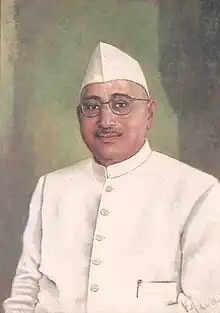Sri Prakasa | |
|---|---|
 | |
| Governor of Bombay (Maharashtra from 1960) | |
| In office 10 December 1956 – 16 April 1962 | |
| Chief Minister | Yashwantrao Chavan |
| Preceded by | Harekrushna Mahatab |
| Succeeded by | P. Subbarayan |
| Governor of Madras | |
| In office 12 March 1952 – 10 December 1956 | |
| Chief Minister | P. S. Kumaraswamy Raja C. Rajagopalachari K. Kamaraj |
| Preceded by | Krishna Kumarsinhji Bhavsinhji |
| Succeeded by | A. J. John |
| Governor of Assam | |
| In office 16 February 1949 – 27 May 1950 | |
| Chief Minister | Gopinath Bordoloi |
| Preceded by | Ronald Francis Lodge (Acting) |
| Succeeded by | Jairamdas Daulatram |
| 1st Indian High Commissioner to Pakistan | |
| In office 1947–1949 | |
| Prime Minister | Jawaharlal Nehru |
| Preceded by | Office Established |
| Succeeded by | Sita Ram |
| Personal details | |
| Born | 3 August 1890 Varanasi, United Provinces, British India |
| Died | 23 June 1971 (aged 80) |
| Alma mater | Central Hindu Boys School , University of Cambridge |
| Awards | Padma Vibhushan |
Sri Prakasa (3 August 1890 – 23 June 1971) was an Indian politician, freedom-fighter and administrator. He served as India's first High Commissioner to Pakistan from 1947 to 1949, Governor of Assam from 1949 to 1950, Governor of Madras from 1952 to 1956 and Governor of Bombay from 1956 to 1962.
Sri Prakasa was born in Varanasi in 1890. In his early days, he participated in the Indian independence movement and was jailed. After India's independence, he served as an administrator and cabinet minister. Sri Prakasa died in 1971 at the age of 80.
Early life
Sri Prakasa was born on 3 August 1890 in Varanasi to Bhagwan Das.[1] He had his schooling at Central Hindu Boys' School C.H.B.S. (B.H.U.) Varanasi and graduated from Cambridge.[1][2]
Indian independence movement
Prakasa was arrested during the Quit India Movement and was in jail from 1942 to 1944.[3]
High Commissioner to Pakistan
In August 1947, Sri Prakasa was appointed India's first High Commissioner to Pakistan and served in the post till 1949. During this time, Pakistan was gripped by communal riots and Sri Prakasa had to deal with the influx of refugees to India and the granting of Indian citizenship to migrants. Sri Prakasa had also to represent India's diplomatic interests during Pakistan's invasion of Kashmir.
Governor of Assam
Sri Prakasa served as the governor of Assam from 16 February 1949 to 27 May 1949. When Prakasa took over as governor, there were serious disturbances in the eastern parts of the province which were inhabited by the Mizo Hill tribes. The Governor pacified the agitators by promising to grant sufficient autonomy. As a result, a Lushai Hills Advisory Council was set up. During his short tenure, he secured the accession of Manipur.[4][5]
Governor of Madras
Sri Prakasa was elected to Lok Sabha from Prayagraj in 1952 but was quite soon appointed the Governor of Madras. He served as the governor of Madras from 1952 to 1956. While governor, he took the highly criticized decision to invite C. Rajagopalachari to form a Congress government in the state despite the fact that the Indian National Congress did not have a majority and Rajagopalachari was not an elected member of the assembly as he had not participated in the elections.[6][7][8] Rajagopalachari requested Prakasa to nominate him to the assembly thereby foregoing the usual process of election by the members of the assembly. However, Rajagopalachari resigned in two years because of strong opposition to his leadership among party ranks. P.C. Alexander, a former Tamil Nadu and Maharashtra governor, viewed the behaviour of the governor and the chief minister of Madras in 1952 as one of the most serious breaches of the democratic process.[9]
Governor of Bombay
Sri Prakasa served as the governor of Bombay.
Notes
- 1 2 Siba Pada Sen (1974). Dictionary of national biography. Institute of Historical Studies. pp. 259.
- ↑ Rajeshwar Dayal (1998). A life of our times. Orient Blackswan. p. 56. ISBN 978-81-250-1546-8.
- ↑ Y. D. Gundevia (1985). Outside the Archives. University of Nevada. p. 321. ISBN 978-0-86131-723-3.
- ↑ Sajal Nag (1998). India and North-East India: mind, politics and the process of integration, 1946–1950. Daya Books. p. 110. ISBN 978-81-86030-76-9.
- ↑ John Parratt (1998). Wounded Land: Politics and Identity in Modern Manipur. Mittal Publications. p. 112. ISBN 978-81-86030-76-9.
- ↑ "Leader, amend thy mind". The Indian Express. 8 November 1997. Archived from the original on 24 September 2012.
- ↑ "Towards a new political culture". The Times of India. 20 May 2006. Archived from the original on 19 June 2007.
- ↑ Mehta, Pratap Bhanu (3 March 2005). "Party Powered - The office of the governor exposes the Congress's Achilles heel". The Telegraph. Archived from the original on 8 March 2005. Retrieved 4 November 2021.
- ↑ "Of Governors and Chief Ministers". The Hindu. 31 May 2001. Retrieved 4 November 2021.